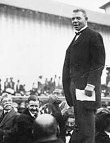|
|
 |
 |
|
Reading Guide |
| 1. |
Racial Politics
| - | Frances Harper, "Open Questions," Ch. 26 of Iola Leroy, 1893 |
| - | Images of African American political action, 1860s-1910s |
|
|
 Booker T. Washington,
1912 |
After emancipation, black organizations made great strides in building institutions for educational, economic, and social uplift. By the 1890s, however, it was obvious that white opposition and violence would continue to worsen throughout the nation—white supremacy campaigns, enforced segregation, disenfranchisement, and lynchings (to which the federal government turned a blind eye). Now black leaders had to enter the political arena in a new way, not just as legislators and state officials, but as initiators of political action.
To begin this topic, we read a chapter from Frances Harper's 1892 novel Iola Leroy, which, according to the New York Times, was "probably the best-selling novel by an African-American before the twentieth century." Harper, a writer, teacher, and political activist, uses her novel as a platform for arguing the logic of equal rights for African Americans. In this chapter the "open questions" of white supremacy and racial justice are debated by a northerner, Dr. Gresham, and his southern visitor Dr. Latrobe. Their interchange encapsulates the racial politics of the 1890s. In tandem with "Open Questions," peruse the fifteen images of African American postbellum political action (ten engravings and five photographs). Note the settings and variety of the political activity depicted in the images (created primarily by white observers). 6 pages, plus any images you may choose to print.
Discussion questions
- What are the unique benefits and risks of political action by African Americans in this period?
- In Iola Leroy, how does the southerner Dr. Latrobe defend "suppressing the negro's vote?" With what strategies does Gresham counter his arguments?
- To what extent do you think Harper's novel influenced white opinion at the time?
- What is the range of political action depicted in the images?
- What is evident in the images that defines the "racial politics" of this era?
|
» Link |
 |
 |
Topic Framing Questions
| • |
What forms of political action did African Americans initiate? For what goals? |
| • |
How was political action affected by the increase in discrimination and violence during the 1890s? |
| • |
How did black leaders frame their political objectives for their white audience? |
| • |
To what extent did black political action affect the lives of ordinary African Americans? |
|
|
 |
 |
|
 |
